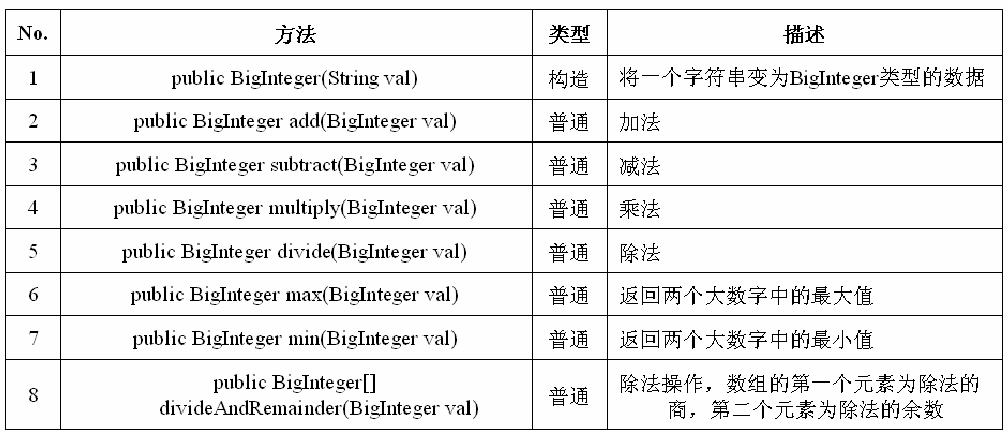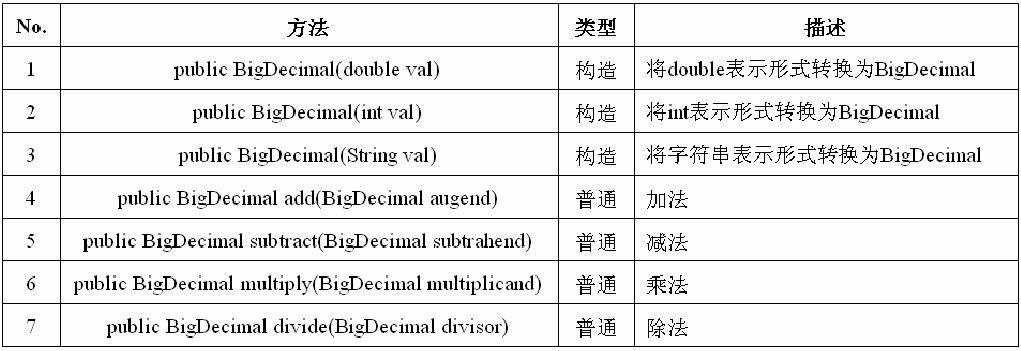本文目标
可以使用BigInteger操作大整数
可以使用BigDecimal指定小数的保留位数
基础知识
对于二进制来说,最高位代表正负号,-0表示-128,+0表示0
32位系统int型4个字节:-(2的31次方) ~ (2的31次方) 减 1
最大负数:10000000 00000000 00000000 00000000
最大正数:01111111 11111111 11111111 11111111
0: 00000000 00000000 00000000 00000000
64位系统同理,int型表示范围是:-(2的63次方) ~ (2的63次方) 减 1
具体内容
大数操作
正常情况下一个整数最多只能放在long类型之中,但是如果现在有如下的一个数字:
1111111111111111111111111111111111111111111111111
根本就是无法保存的,所以为了解决这样的问题,在java中引入了两个大数的操作类:
操作整型:BigInteger
操作小数:BigDecimal
当然了,这些大数都会以字符串的形式传入。
BigInteger
如果在操作的时候一个整型数据已经超过了整数的最大类型长度long的话,则此数据就无法装入,所以,此时要使用BigInteger类进行操作。
BigInteger是在java.math包中。
代码示例:
- package ustc.lichunchun.bigdataapi;
- import java.math.BigInteger;
- public class BigIntegerDemo1 {
- public static void main(String[] args) {
- BigInteger bi1 = new BigInteger("123456789") ; // 声明BigInteger对象
- BigInteger bi2 = new BigInteger("987654321") ; // 声明BigInteger对象
- System.out.println("加法操作:" + bi2.add(bi1)) ; // 加法操作
- System.out.println("减法操作:" + bi2.subtract(bi1)) ; // 减法操作
- System.out.println("乘法操作:" + bi2.multiply(bi1)) ; // 乘法操作
- System.out.println("除法操作:" + bi2.divide(bi1)) ; // 除法操作
- System.out.println("最大数:" + bi2.max(bi1)) ; // 求出最大数
- System.out.println("最小数:" + bi2.min(bi1)) ; // 求出最小数
- BigInteger result[] = bi2.divideAndRemainder(bi1) ; // 求出余数的除法操作
- System.out.println("商是:" + result[0] +
- ";余数是:" + result[1]) ;
- }
- }
发现divide()方法本身只是把最终的商保存下来了,但是这样的两个数字相除的时候肯定是无法整除,肯定存在余数,所以我们在上面代码中还用到了divideAndRemainder()方法来获得结果和余数。
BigDecimal
使用此类可以完成大的小数操作,而且也可以使用此类进行精确的四舍五入,这一点在开发中经常使用。
对于不需要任何准确计算精度的程序可以直接使用float或double完成,但是如果需要精确计算结果,则必须使用BigDecimal类。
代码示例:
- package ustc.lichunchun.bigdataapi;
- import java.math.BigDecimal;
- public class BigDecimalDemo01 {
- public static void main(String[] args) {
- System.out.println("加法运算:" + MyMath.round(MyMath.add(10.345,3.333),1)) ;
- System.out.println("减法运算:" + MyMath.round(MyMath.sub(10.345,3.333),3)) ;
- System.out.println("乘法运算:" + MyMath.round(MyMath.mul(10.345,3.333),4)) ;
- System.out.println("除法运算:" + MyMath.div(10.345,3.333,3)) ;
- }
- }
- class MyMath{
- public static double add(double d1,double d2){ // 进行加法计算
- BigDecimal b1 = new BigDecimal(d1) ;
- BigDecimal b2 = new BigDecimal(d2) ;
- return b1.add(b2).doubleValue() ;
- }
- public static double sub(double d1,double d2){ // 进行减法计算
- BigDecimal b1 = new BigDecimal(d1) ;
- BigDecimal b2 = new BigDecimal(d2) ;
- return b1.subtract(b2).doubleValue() ;
- }
- public static double mul(double d1,double d2){ // 进行乘法计算
- BigDecimal b1 = new BigDecimal(d1) ;
- BigDecimal b2 = new BigDecimal(d2) ;
- return b1.multiply(b2).doubleValue() ;
- }
- public static double div(double d1,double d2,int len){ // 进行除法计算
- BigDecimal b1 = new BigDecimal(d1) ;
- BigDecimal b2 = new BigDecimal(d2) ;
- return b1.divide(b2,len,BigDecimal.ROUND_HALF_UP).doubleValue() ;
- }
- public static double round(double d,int len){ // 进行四舍五入
- BigDecimal b1 = new BigDecimal(d) ;
- BigDecimal b2 = new BigDecimal(1) ; // 技巧
- return b1.divide(b2,len,BigDecimal.ROUND_HALF_UP).doubleValue() ;
- }
- };
华为机试题
现在我们来看一道华为的机试题:
写出一个程序,接受一个十六进制的数值字符串,输出该数值的十进制字符串。(多组同时输入 )
一开始,我写的答案是这样的:
- package huawei.job;
- import java.io.BufferedReader;
- import java.io.IOException;
- import java.io.InputStreamReader;
- import java.math.BigInteger;
- public class Main5 {
- public static void main(String[] args) {
- BufferedReader bufr = new BufferedReader(new InputStreamReader(System.in));
- String line ;
- BigInteger base = new BigInteger("16");
- try {
- while((line = bufr.readLine()) != null){
- line = line.substring(2);
- int result = Integer.parseInt(line, 16);
- System.out.println(result);
- }
- } catch (IOException e) {
- e.printStackTrace();
- }
- }
- }
- package huawei.job;
- import java.io.BufferedReader;
- import java.io.IOException;
- import java.io.InputStreamReader;
- import java.math.BigInteger;
- public class Main5 {
- public static void main(String[] args) {
- BufferedReader bufr = new BufferedReader(new InputStreamReader(System.in));
- String line ;
- BigInteger base = new BigInteger("16");
- try {
- while((line = bufr.readLine()) != null){
- line = line.substring(2);
- //int result = Integer.parseInt(line, 16);
- BigInteger result = new BigInteger("0");
- for(int i = 0; i < line.length(); i++){
- char ch = line.charAt(line.length()-1-i);
- if(ch >= 'A' && ch <= 'F'){
- BigInteger tmp = base.pow(i).multiply(new BigInteger(Integer.toString((ch - 'A' + 10))));
- result = result.add(tmp);
- }else{
- BigInteger tmp = base.pow(i).multiply(new BigInteger(Character.toString(ch)));
- result = result.add(tmp);
- }
- }
- System.out.println(result);
- }
- } catch (IOException e) {
- e.printStackTrace();
- }
- }
- }
转载来自:http://blog.csdn.net/zhongkelee/article/details/52289163

























 517
517

 被折叠的 条评论
为什么被折叠?
被折叠的 条评论
为什么被折叠?








